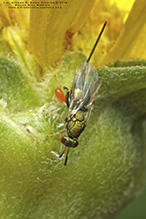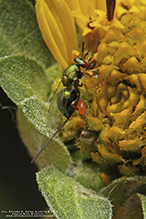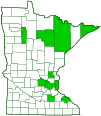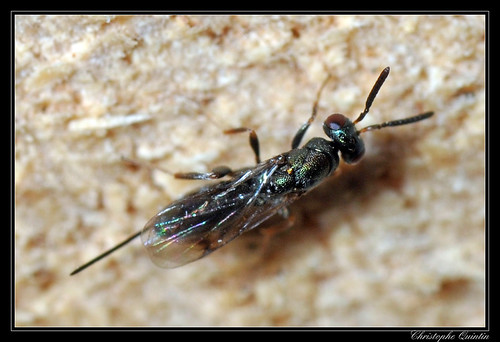torymid wasps
(family Torymidae)
Overview • Description • Distribution • Taxonomy
Description |
||
Torymid wasps are small, 1⁄32″ to 5⁄16″ (1.1 to 7.5 mm) in length, not including the ovipositor. Most are just 1⁄16″to ⅛″ (2 to 4 mm) long. Most are metallic green. The thorax is sculptured. The large principal plate on the upper part of the thorax (mesoscutum) has a line (parapsidial line or parapsidial suture) on each side that correspond to a muscle beneath the plate. On almost all species, the slender body segment connecting the thorax and abdomen (petiole) is transverse, not distinct. The abdomen is smooth and shiny. The first segment (coxa) of the hind leg is much larger than the coxa of the front leg. The third segment (femur) of the hind leg is slender. On the forewing the hairs (setae) are long, the marginal vein is long, and the dark cell on the leading edge (stigma) is very short. On the female the abdomen is compressed laterally. The ovipositor is clearly exserted and is as long as the abdomen or sometimes much longer. The third segment (femur) of the hind leg is swollen. |
||
Distribution |
||||
|
Sources |
|||
| 9/28/2022 | ||||
Taxonomy |
|||
Order |
Hymenoptera (ants, bees, wasps, and sawflies) | ||
Suborder |
Apocrita (narrow-waisted wasps, ants, and bees) | ||
| Infraorder | Proctotrupomorpha | ||
Superfamily |
Chalcidoidea (chalcidoid wasps) | ||
Subordinate Taxa |
|||
Subfamily Chalcimerinae Subfamily Glyphomerinae Subfamily Megastigminae Subfamily Microdontomerinae Subfamily Monodontomerinae Subfamily Podagrioninae Subfamily Thaumatoryminae Subfamily Toryminae |
|||
Synonyms |
|||
|
|||
Common Names |
|||
torymid wasps torymids |
|||
Glossary
Coxa
The first (most proximal) segment of the legs of most arthropods, including all insects, spiders, and crustaceans, and most arachnids. It attaches the leg to the body and connects to the trochanter. Plural: coxae.
Femur
On insects and arachnids, the third, largest, most robust segment of the leg, coming immediately before the tibia. On humans, the thigh bone.
Ovipositor
A tube-like organ near the end of the abdomen of many female insects, used to prepare a place for an egg and to place the egg.
Petiole
On plants: The stalk of a leaf blade or a compound leaf that attaches it to the stem. On ants and wasps: The constricted first one or two segments of the rear part of the body.
Stigma
In plants, the portion of the female part of the flower that is receptive to pollen. In Lepidoptera, an area of specialized scent scales on the forewing of some skippers, hairstreaks, and moths. In other insects, a thickened, dark, or opaque cell on the leading edge of the wing.
Visitor Photos |
|||||
Share your photo of this insect. |
|||||
| This button not working for you? Simply email us at info@MinnesotaSeasons.com. Attach one or more photos and, if you like, a caption. |
|||||
Alfredo Colon |
|||||
 |
 |
||||
MinnesotaSeasons.com Photos |
|||||
|
|||||

Visitor Videos |
|||
Share your video of this insect. |
|||
| This button not working for you? Simply email us at info@MinnesotaSeasons.com. Attach a video, a YouTube link, or a cloud storage link. |
|||
Other Videos |
|||

Created: 9/28/2022
Last Updated:





